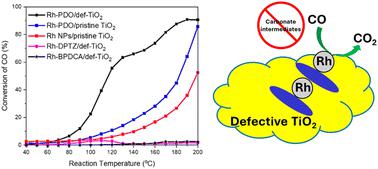当前位置:
X-MOL 学术
›
Catal. Sci. Technol.
›
论文详情
Our official English website, www.x-mol.net, welcomes your feedback! (Note: you will need to create a separate account there.)
CO oxidation over a ligand coordinated single site Rh catalyst: identification of the active complex
Catalysis Science & Technology ( IF 4.4 ) Pub Date : 2024-07-31 , DOI: 10.1039/d4cy00507d Fereshteh Rezvani 1 , Xuemei Zhou 1, 2 , Debora Motta Meira 3 , George E. Sterbinsky 4 , Steven L. Tait 1
Catalysis Science & Technology ( IF 4.4 ) Pub Date : 2024-07-31 , DOI: 10.1039/d4cy00507d Fereshteh Rezvani 1 , Xuemei Zhou 1, 2 , Debora Motta Meira 3 , George E. Sterbinsky 4 , Steven L. Tait 1
Affiliation

|
Single atom catalysis has evolved as a promising strategy to enhance atom utilization efficiency, lower reaction temperatures, and control reaction pathways in heterogeneous catalytic reactions. An important challenge using supported single atom catalysts is the stability of metal single atoms during reactions. Here, we present an approach to stabilize single rhodium atoms on a titania support via a metal–ligand coordination strategy. We explore the reaction activity and mechanism of CO oxidation, as well as the stability under oxidative reaction conditions. Kinetic studies suggest that, with an excess of oxygen in the feed gas, oxygen activation is more facile on defective titania surfaces than on pristine titania surfaces. In situ diffuse reflectance infrared Fourier transform spectroscopy (DRIFTS) analysis shows that on the pristine titania surface, the 1,10-phenanthroline-5,6-dione (PDO) coordinated Rh catalyst (Rh–PDO/TiO2) catalyzes CO oxidation via the formation of carbonate-like species, which is similar to what occurs on Rh nanoparticle catalysts. However, on the defective titania surface, no carbonate species form for Rh–PDO/def-TiO2. The supported Rh–ligand catalysts are also shown to be very stable in such a reaction environment at elevated temperatures, potentially allowing for wide applications.
中文翻译:

配体配位单中心 Rh 催化剂上的 CO 氧化:活性络合物的鉴定
单原子催化已发展成为一种有前景的策略,可提高多相催化反应中的原子利用效率、降低反应温度和控制反应路径。使用负载型单原子催化剂的一个重要挑战是反应过程中金属单原子的稳定性。在这里,我们提出了一种通过金属配体配位策略在二氧化钛载体上稳定单个铑原子的方法。我们探讨了CO氧化的反应活性和机理,以及氧化反应条件下的稳定性。动力学研究表明,当原料气中氧气过量时,有缺陷的二氧化钛表面上的氧活化比原始二氧化钛表面上更容易。原位漫反射红外傅里叶变换光谱(DRIFTS)分析表明,在原始二氧化钛表面,1,10-菲咯啉-5,6-二酮(PDO)配位Rh催化剂(Rh-PDO/TiO 2 )通过催化CO氧化碳酸盐类物质的形成,这与 Rh 纳米粒子催化剂上发生的情况类似。然而,在有缺陷的二氧化钛表面上,没有形成Rh-PDO/def-TiO 2的碳酸盐物种。负载型 Rh 配体催化剂在高温反应环境中也表现出非常稳定,具有广泛的应用前景。
更新日期:2024-07-31
中文翻译:

配体配位单中心 Rh 催化剂上的 CO 氧化:活性络合物的鉴定
单原子催化已发展成为一种有前景的策略,可提高多相催化反应中的原子利用效率、降低反应温度和控制反应路径。使用负载型单原子催化剂的一个重要挑战是反应过程中金属单原子的稳定性。在这里,我们提出了一种通过金属配体配位策略在二氧化钛载体上稳定单个铑原子的方法。我们探讨了CO氧化的反应活性和机理,以及氧化反应条件下的稳定性。动力学研究表明,当原料气中氧气过量时,有缺陷的二氧化钛表面上的氧活化比原始二氧化钛表面上更容易。原位漫反射红外傅里叶变换光谱(DRIFTS)分析表明,在原始二氧化钛表面,1,10-菲咯啉-5,6-二酮(PDO)配位Rh催化剂(Rh-PDO/TiO 2 )通过催化CO氧化碳酸盐类物质的形成,这与 Rh 纳米粒子催化剂上发生的情况类似。然而,在有缺陷的二氧化钛表面上,没有形成Rh-PDO/def-TiO 2的碳酸盐物种。负载型 Rh 配体催化剂在高温反应环境中也表现出非常稳定,具有广泛的应用前景。





































 京公网安备 11010802027423号
京公网安备 11010802027423号